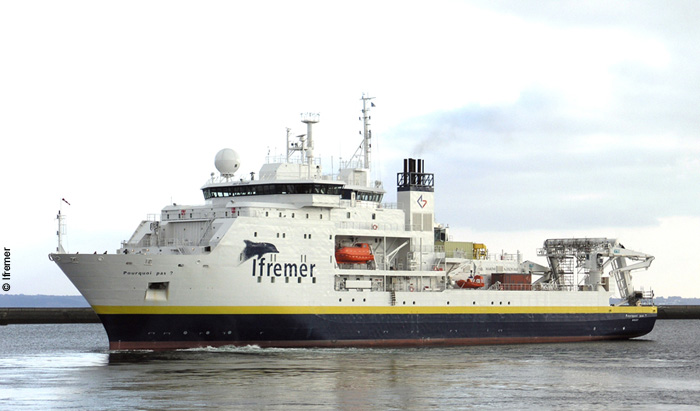Pourquoi Pas?
Entity attached to:
Main activity
Multi-disciplinary deep-sea vessel, 107.6m long, capable of sailing in all oceans. Deep-sea and coastal hydrography with deployment of hydrographic survey launches. Exploration of the water column and currents. Underwater mapping using sonar and description of the sub-soil (seismic, gravimetric, magnetic). Multi-level study of physical, biological or geological processes. Site reconnaissance using acoustics, deploying: towed acoustic systems (TAS), remotely operated systems (Victor 6000) or independent systems (Nautile), positioning heavy gear close to the sea bed by cable (Penfeld). Collecting and analysing samples of water, living material, sediment or rocks (core boring, dredging). Deploying the navy's Newtsuit system to assist submarines in difficulty.
Description
Certification, standardization, calibration
Category
Observation
Research vessels, their underwater systems and air assets
Coastal
Offshore
Vessels
Research vessels, their underwater systems and air assets
Coastal
Offshore
Vessels
hasafcfaf18-c675-48af-beca-8bb1ff090072
Scientific disciplines
Marine geosciences / Geology / Sedimentology / Seismology
Marine biochemistry / Marine biogeochemistry / Marine chemistry
Bioinformatics
Molecular biology / Cellular biology
Health / Medicins
Acoustics
Metrology
Marine Engineering
Mechanics
Marine geomatics / Habitat mapping
Microbiology
Bathymetry
Hydrology / Hydrography
Biological oceanography
Marine Ecology
Fisheries
Physical oceanography
Genomics / Genetics
Marine biochemistry / Marine biogeochemistry / Marine chemistry
Bioinformatics
Molecular biology / Cellular biology
Health / Medicins
Acoustics
Metrology
Marine Engineering
Mechanics
Marine geomatics / Habitat mapping
Microbiology
Bathymetry
Hydrology / Hydrography
Biological oceanography
Marine Ecology
Fisheries
Physical oceanography
Genomics / Genetics
Strategic areas of action
Marine energy and mining resources
Environmental and coastal planning and development
Marine biological resources
Environmental and coastal planning and development
Marine biological resources

Examples of work
Type of entity
Equipment
Keywords
Oceanographic Fleet, Research Vessel, Marine Environment, Oceanography, Waterbodies, Submarine Resources, Geosciences, Biology, Physics, Fisheries Science, Paleoclimatology, Geochemistry, Ecology, Genetics, Biodiversity, Teaching, Observation, Marine Technology
Modification date: 09/04/2025 01:13:50
For details of the service, see the related platform or infrastructure
A pioneer in ocean science, IFREMER's cutting-edge research is grounded in sustainable development and open science.His vision is to advance science, expertise and innovation to protect and restore the ocean, sustainably use marine resources to benefit societ, create and share ocean data, information & knowledge.
With more than 1,500 personnel spread along the French coastline in more than 20 sites, the institute explores the 3 great oceans: the Indian, Atlantic and Pacific oceans.
Founded in 1984, IFREMER is a French public organization and its budget approximates 240 million euros. It is operating under the joint authority of the French Ministry for Higher Education, Research and Innovation, the French Ministry for the Ecological and Solidary Transition, and the French Ministry of Agriculture and Food.
With more than 1,500 personnel spread along the French coastline in more than 20 sites, the institute explores the 3 great oceans: the Indian, Atlantic and Pacific oceans.
Founded in 1984, IFREMER is a French public organization and its budget approximates 240 million euros. It is operating under the joint authority of the French Ministry for Higher Education, Research and Innovation, the French Ministry for the Ecological and Solidary Transition, and the French Ministry of Agriculture and Food.
Adress
Ifremer
Address line 2
ZI Pointe du Diable
Zip code/Postcode
29280
Town/city
PLOUZANÉ





